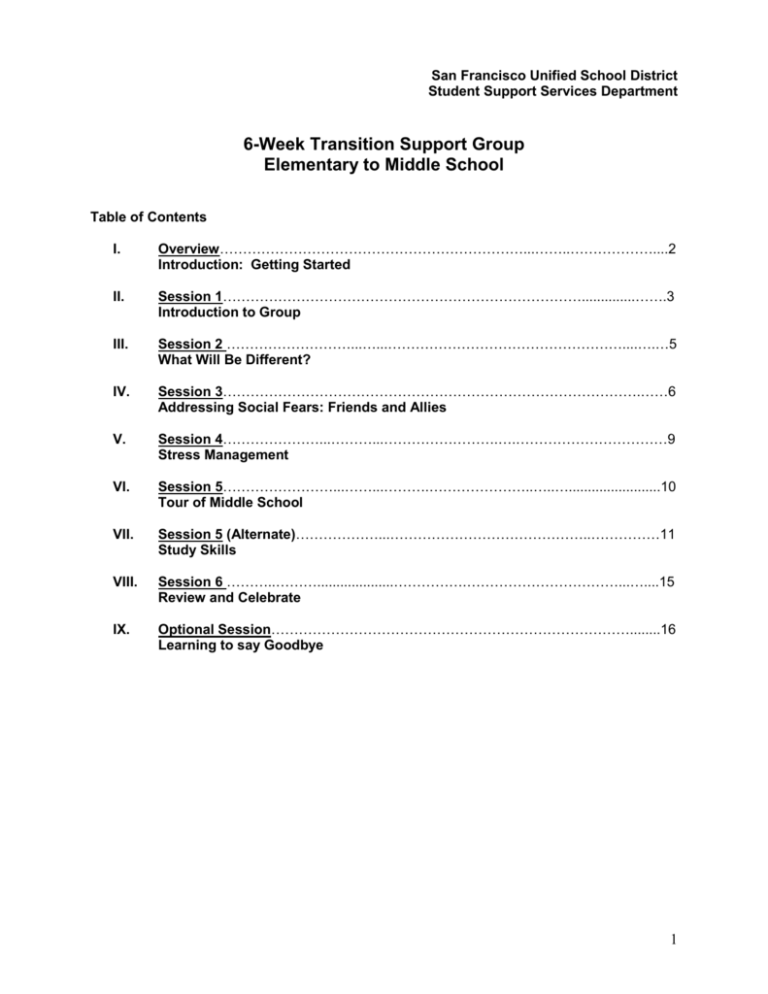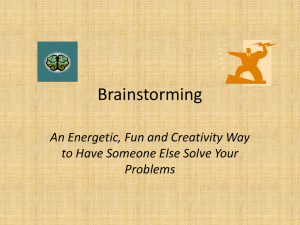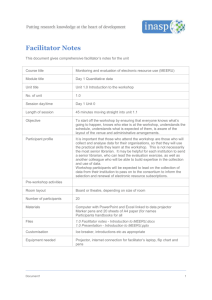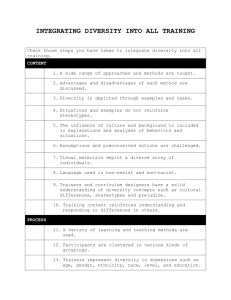Transition Group Topics - SFUSD School Health Programs
advertisement

San Francisco Unified School District Student Support Services Department 6-Week Transition Support Group Elementary to Middle School Table of Contents I. Overview…………………………………………………………...……..………………....2 Introduction: Getting Started II. Session 1……………………………………………………………………..............…….3 Introduction to Group III. Session 2 ………………………...…...……………………………………………....….…5 What Will Be Different? IV. Session 3……………………………………………………………………………….……6 Addressing Social Fears: Friends and Allies V. Session 4…………………...………...…………………….….……………………………9 Stress Management VI. Session 5……………………...……...……….…………………..…..…........................10 Tour of Middle School VII. Session 5 (Alternate)………………...……………………………………..……………11 Study Skills VIII. Session 6 ………..………....................…………….……………………………...…....15 Review and Celebrate IX. Optional Session……………………………………………………………………........16 Learning to say Goodbye 1 Overview The transition to middle school is marked by several changes in educational expectations and practices. In most elementary schools, children are taught in self-contained classrooms with a familiar set of peers and one or two teachers. Once students reach middle school, however, they must interact with more peers and teachers, and will face intensified expectations for both performance and individual responsibility. Social, developmental, and academic experiences are affected, requiring them to adjust to new settings, structures, and expectations. All of this comes at a time when they are also experiencing a host of changes associated with the transition from childhood to adolescence. They are beginning to mature physically, and thinking of themselves as individuals separate from their families. Their attentions turn to exercising independence and developing strong relationships with peers, while avoiding exposure and embarrassment. The atmosphere at home may also become strained as families struggle with redefining roles and relationships. This complicated period of transition has often been associated with a decline in academic achievement, performance motivation, and self-perceptions. The more prepared students are for these transitions, the more successful they will be. Introduction: Getting Started The following group activities are designed to provide support and address the needs of students as they transition from elementary to middle school. Selecting Participants: In considering participants for group, it may be easier to select students previously identified as needing additional academic and social support services (e.g., students referred to the Student Assistance Program (SAP), students eligible for Families & Youth in Transition (FYIT) services, or those to be referred through the Transition Program). However, it is also important to have a balance of participants with varying needs and abilities so members can learn different skills from each other. Keep in mind every prospective member’s cultural background. It is imperative that the facilitator be cognizant of multicultural differences among group members and incorporate these aspects into the group curriculum. This includes consideration of developmental levels. It may be helpful for the facilitator to meet each student one-on-one to assess his/her fit for the group, gain consent, and evaluate how the student currently perceives the upcoming transition. This is also an opportunity for the student to begin considering his/her feelings about middle school. The facilitator should explain the logistics of the group: size, length of sessions, duration, and general expectations. Logistics: Group Size: approximately 6 to 8 Length of Sessions: Depending on the number of participants and the developmental levels, the time frame for each group is estimated at 30-45 minutes. Materials: The materials needed for each group will vary depending on the number of group participants and their developmental levels; please plan accordingly. Material adapted from: http://arkansased.org/parental_involvement/transitions/elem-mid.ppt http://www.nmsa.org/AboutNMSA/PositionStatements/TransitioningStudents Ready-to-Use Social Skills Lessons & Activities for Grades 7-12 (JB Ed: Ready-to-Use Activities): Ruth Weltmann Begun: Books. http://printables.scholastic.com 2 Session One – Introduction to Group Goals: Participants will be able to: State the purpose, goals, and expectations of the group. Get to know other members of the group. Articulate one personal goal for the group, and begin indentifying and expressing thoughts and feelings regarding the transition to middle school. Pre-group preparation: Prepare a butcher paper for Group Agreements Write a list of questions, numbered 1-6, on a piece of butcher paper (for example, “What’s your favorite color?” “What are you looking forward to about middle school?” “What do you like most about elementary school?”, etc.) Obtain dice and index cards * Set up middle school tour for Session 5: Call Student Support Service Staff member at a middle school to set up tour, schedule, and request panel of middle school students; obtain field trip permission forms and prepare logistics (e.g. transportation, food, etc.) Materials: Pencils Markers Dice Index cards Blank butcher paper (at least 5 pieces) Butcher paper with pre-written questions Discussion: You are all in fifth grade now and will be preparing this year for a very important transition in your lives. What does “transition” mean? (The process of changing or passing from one activity, state or place to another). Give examples of the many kinds of transitions there are, including ones they have already successfully made (beginning each new school year, moving to a new place, etc.) The transition you will be making at the end of this year is not only to a new grade, but also to a new school that will probably be much bigger than you’re used to. This group was created to help students prepare for the transition to middle school. We will begin our group by establishing some group agreements. Activity 1 – Group Name and Agreements: Explain to participants that when working in a group it’s helpful to develop agreements around what we expect from each other so we can feel safe and comfortable to share. Tape butcher paper on the wall and label it “Group Agreements.” Ask group to brainstorm Group Agreements; explain and provide examples as needed. Make sure list includes confidentiality, right to pass, and mutual respect. Ask each participant to sign his/her name on the paper. Facilitator should bring Group Agreements to each session. Ask members to work together to name the group; help lead discussion. Activity 2 – Roll the Dice: Post butcher paper with pre-written questions on the wall. Ask participants to take turns rolling the dice and answering the question that corresponds to the number on the dice. 3 Activity 3 – Question/Fear/Goal: Pass out an index card and pencil to each group member. Instruct group members to anonymously write one: a) Question about going to middle school b) Fear about going to middle school c) Goal describing something they hope to learn or get from the group Facilitator reads cards aloud, normalizing thoughts and feelings, describing how group will address each, and dispelling myths. Facilitator should keep “Question/Fear/Goal” index cards for future sessions. 4 Session Two – What Will Be Different? Goals: Participants will be able to: Better identify differences between elementary and middle school. Identify organization strategies to be successful in middle school. Pre-group preparation: Obtain two combination locks; write instructions for opening lock on butcher paper Prepare binders where materials are disorganized (one for each pair of participants) Prepare an organized binder with headings, dividers, etc. Obtain and fill out permission slips for middle school tour Materials: Combination locks and instructions Messy binders and organized binder Field trip permission forms Post group agreements and goals for the session Activity 1 – What’s Changed?: Facilitator or volunteer stand in front of the group while participants notice everything they can about his/her appearance. Volunteer then leaves the room or goes behind a door or screen, and changes two things about his/her appearance. Volunteer comes back and participants take turns individually to guess what has changed; whoever guesses correctly goes next. Discussion Questions: What are some small changes? Will you notice them? What are some big changes? How will you adjust? Address any fears or concerns that may come up in this discussion. Let students know that in a few weeks the group will be taking a field trip to a middle school. Distribute permission slips and answer any questions. Activity 2 – Combination Lock 101: Refer to combination lock instructions and demonstrate how to open a combination lock. Pass locks around for participants to practice. Activity 3 – Organization Training: Have participants break up into pairs. Show group members an organized binder, pointing out dividers, subject headings, organized papers, etc. Distribute messy binders and ask pairs to organize binders however they’d like. When everyone has finished, pairs present their binders to the group, explaining their organization process. Discussion: Begin a discussion with students about organization: What is it? Can you give examples of things that are organized in your life now (e.g., clothes, refrigerator, toys, books, etc.)? Why do we organize things? What are some of the challenges of organization? How will it help in middle school? 5 Session Three – Addressing Social Fears: Friends and Allies Goals: Participants will be able to: Explore social fears associated with going to middle school. Identify support service staff at middle school level. Describe how to access help in difficult social situations. Pre-group preparation: Write out any social fears from Session One’s “Question/Fear/Goal” index cards on a butcher paper titled “Middle School Fears” Review “Middle School Support Staff” bubble diagram for use in Activity 2 Copy “Social Situations” handout and cut into slips Materials: Markers “Middle School Fears” butcher paper Butcher paper or white board for brainstorm activity “Social Situations” slips for each participant Post group agreements and goals for the session Activity 1 – Identifying Fears: Post “Middle School Fears” butcher paper on the wall and ask participants if there are any other social fears to add. Write any additional fears onto butcher paper. Explain that today’s session will focus on addressing social fears. Activity 2 – Middle School Support Staff: Participants brainstorm a list of middle school staff they can go to for support. Facilitator records responses in a bubble diagram adding any additional staff not mentioned and clarifying roles of each staff as needed. Discussion: Every school has a number of people you can go to for support. These people might be different at each school, which is why it is important to become familiar with the staff at your school. For example, at some schools the school secretary is often a great support to students and often knows who everybody is. In our next activity, we will be looking at who we can turn to at school in difficult social situations. Activity 3 – Social Situations: Have participants break up into pairs and distribute “Social Situations” slips. Ask pairs to think about their situation and discuss what they would do and who they would go to for help. Tell participants to refer to bubble diagram from Activity 2. Ask pairs to share with the group. Discussion: What was useful about today’s session? Explain. Ask participants to name a middle school support staff person and explain how this person could help them. Remind participants about permission slips. Ask that they return permission slips next session. 6 [Sample Diagram] Middle School Support Staff School Psychologist Learning Support Professional (LSP) School Counselor Student Advisor Principal Middle School Support Staff Parent Liaison Assistant Principal Afterschool Program Staff Nurse 7 Social Situations Your lunch money is stolen. Someone ratted to a teacher about something you did. You have been dared into a fight that you think you’ll lose. You have an allergic reaction at school, causing you to break out. Students make fun of you. Your friends pressure you to steal another student’s iPod. Your friends are all cutting class and want you to join. A classmate tries to cheat off your math test. Someone has posted rumors about you in cyberspace. 8 Session Four – Stress Management Goals: Participants will be able to: Identify stress triggers. Identify and apply relaxation techniques. Pre-group preparation: Prepare list of 4-6 questions related to stress management (e.g., “What makes you feel stressed?” ”Where do you feel relaxed?” “What color makes you think of stress?” etc.) Refer to “Stress Reduction Activities for Students” section in the SSS Curriculum Binder and choose 2-3 activities to teach and practice with participants; for this session, it is recommended to use “Deep Breathing,” “Progressive Relaxation,” and “Visual Imagery” Materials: Paper Pencils Stress management questions Stress reduction activity materials (i.e., scripts) to all participants Post group agreements and goals for the session Activity 1 – Snowball: Distribute paper and pencils. Ask participants to fold paper into four sections and write their names in the upper left-hand box. Facilitator reads out one stress management question, and members write their responses underneath their names. Participants then crumple the papers up into balls (snowballs). On the count of 3, members toss papers into the center of the circle or towards a designated place. Each participant selects a snowball, not his/her own. Participants then take turns sharing the responses aloud. Papers are returned to their owners and activity is repeated, using different questions each time, until each quadrant is filled. Activity 2 – Stress Reduction Techniques: Facilitator leads the stress reduction activities. Discussion Questions: Did any of the activities help you feel relaxed? If so, which one? What other activities might help you feel relaxed (e.g., journaling, listening to music, drawing, etc.)? Ask participants to share a new stress reduction technique they learned today and will try next time they feel stressed. Activity 3 – Preparing for Middle School Visit: Distribute paper and pencils to participants. Ask participants to write a list of 3-5 questions to ask middle school staff and students. Facilitator can provide examples of appropriate questions. Have participants break up into pairs and practice asking their questions with each other. Discussion: Remind participants that the group will be taking a field trip to a middle school next session. Review behavioral expectations for the middle school visit. Participants who have not turned in permission slips should do so as soon as possible in order to participate in the field trip. 9 Session Five – Tour of Middle School Goals: Participants will be able to: Increase their comfort and understanding of the middle school setting. Learn more about life as a middle school student. Pre-group preparation: Obtain school map for participants to follow during tour Materials: Field trip permission forms Student questions School map Activity 1 – School Tour: Take tour, learn where key offices are located (e.g., Principal, Counseling, etc.) Learn logistical information (e.g., daily schedule, homerooms, etc.) Activity 2 – Middle School Student Panel: Allow middle school students to discuss their transition to middle school. Have participants ask questions. If time and scheduling permits, plan for participants to eat lunch or a snack together. Discussion: Prior to leaving, debrief with participants about their experience. Are there new questions/concerns that have come up? What are they most looking forward to? Is there anything that surprised them? What is something they would like to know more about? 10 Session Five (Alternate) – Study Skills Goals: Participants will be able to: Set goals and priorities to promote student success. Set up an environment conducive to studying. Pre-group preparation: Copy “Setting Priorities” handout (one per participant) Copy “My Study Plan” handout (one per participant) Copy “Student Success Guide” handout (one per participant) Copy “Obstacles to Concentration” handout (one per participant) Prepare and post 3 pieces of butcher paper with the following headings: Goal 1: Be organized and prepared for school Goal 2: Spend time with family and friends Goal 3: Spend time for myself Materials: Pencils Markers “Setting Priorities” handouts “My Study Plan” handouts “Student Success Guide” handouts “Obstacles to Concentration” handouts Butcher paper Post group agreements and goals for the session Activity 1 – Setting Priorities and Goals: Have participants break up into pairs, distribute “Setting Priorities” handout, and ask pairs to complete it. After completing the priority list, have participants work with their partners to categorize each priority under one of the three goal headings listed on the butcher paper. Ask pairs to assign one person to record answers on butcher paper. Discussion Questions: Was it easy or difficult to set priorities? Were your priorities the same or different as your partners? Why do you think it is important to set priorities? How do you think priorities and goals are related? Why is it important to set goals? Activity 2 – Study Environment: Distribute “My Study Plan” handouts and have participants complete it. As they write, facilitator should create a distraction -hum, talk, or open windows. Explain that these are external distractions while internal distractions, like boredom or hunger, come from inside one’s self. Distribute “Obstacles to Concentration” handouts. Have participants break up into pairs and brainstorm external and internal obstacles to studying, and smart solutions for each. Discussion: What are some external/internal obstacles that you thought of with your partner? How do they distract you from concentrating? What solutions did you come up with? What do you think your study plan will look like when you are in middle school? 11 Setting priorities Each day you are faced with a wide range of things you need or want to do for school, for your family and friends, and for yourself. Below is a list of things you could do on a weekday evening. Arrange them in the order of your priorities. Put the most important task first, the second next, etc.. Organize my backpack for school tomorrow 1._________________________________ Watch my favorite TV show 2._________________________________ Choose clothes to wear to school tomorrow 3._________________________________ Eat dinner with my family 4._________________________________ Call a friend to tell him/her about math homework 5._________________________________ Study for the social studies test being given on Friday 6._________________________________ Begin science project due next Monday 7._________________________________ Instant message with my friends 8._________________________________ Complete math homework due tomorrow 9._________________________________ Play on the computer 10.________________________________ 12 My Study plan 1. The place I study best is: My bedroom The public library The kitchen table The living room Another place: __________________________ 2. I choose this place to study because: ___________________________________________________________________ ___________________________________________________________________ 3. The time I study best is: Early in the morning Right after school After dinner Another time: ____________________________________ 4. This time is best for me because: ___________________________________________________________________ ___________________________________________________________________ 5. I study best: By myself With a parent or another adult With my brother or sister In a study group 6. I need a study break: Every 15 minutes Every 30 minutes Every hour 7. When I take a break, I _______________________________________________ 8. List three things you need in your study environment to be effective learner: ___________________ ___________________ ___________________ 13 Obstacles to concentration Think about times you have felt distracted from studying. Were the obstacles external (such as traffic or television noise) or internal (such as being tired or hungry)? What can you do to get back on track? external External obstacles What to do about it INternal Internal obstacles What to do about it 14 Session Six – Review and Celebrate Goal: Participants will be able to: Reflect on group and identify skills gained. Pre-group preparation: Obtain card making arts and crafts materials: paper, markers, stickers, etc. If possible, purchase folder, planner, or some other organizational item to distribute to participants Obtain a healthy snack Materials: Healthy snack Card making materials: paper, markers, stickers, etc. “Question/Fear/Goal” index cards from Session One Post group agreements and goals for the session Activity 1 – Appreciation Cards: Ask participants to make appreciation cards for people they met during the middle school visit. Ask participants to share their appreciations with group. Facilitator collects cards and mails them to middle school point person. Activity 2 – Review and Celebration: Distribute and eat snacks. Ask participants to reflect on group sessions and activities: Based on what you learned in group, what do you think will be different in middle school? What did you learn about organization? Why is organization important in middle school? Who can you go to if you need help in middle school? What are some techniques you can use if you feel stressed? Distribute organizational gift item. CELEBRATE! 15 Optional Session- Learning to Say Goodbye Goal: Participants will be able to: Process “loss” associated with transition to Middle School Recognize their strengths and accomplishments Pre-group preparation: Put together a bag for each group participant that contains; two smooth, polished stones, and one rough stone, and the poem below Obtain and fill out Certificates of Accomplishment for each group member Materials: Post group agreements and goals for the session Certificate of Accomplishment (optional) A bag with the stones for each participant Activity: The facilitator gives each member a small cloth bag containing three stones and a poem. Two of the stones are smooth, polished, and beautiful. The other rock is rough and plain. The poem says, "Each of us has bright and shiny pieces in our lives, as well as places in our hearts that will always be rough and painful; life can be both difficult and beautiful, remember the things and people that help you get through the rough times." Participants give examples of people and things that have helped them during rough times up until this point in school (this may work better as writing exercise than a verbal discussion depending on when the session is used). Discussion questions: Discuss what the above poem means. Discuss what things or people will be difficult to say goodbye to from their current site. How have you dealt with loss or saying goodbye in the past? Emphasize each member’s coping skills and support systems. Close with a relaxation/guided imagery exercise. 16







